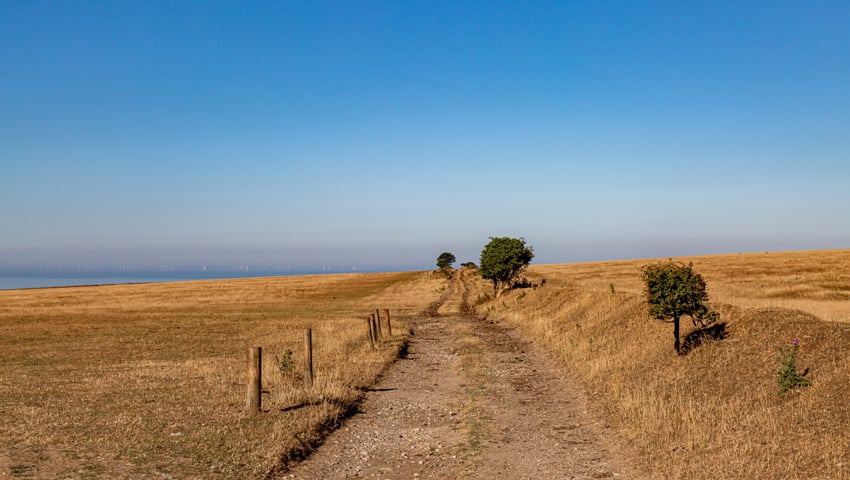A report, Embracing Nature, published by The Wildlife Trusts, identifies drought as the current leading threat to their nature reserves for the first time.
The Wildlife Trusts, who are among the UK’s largest landowners with 2,600 nature reserves covering nearly 100,000 hectares, also point to pollution, invasive species and habitat fragmentation as high risks.
Drought is considered to be the leading threat for the next 30 years, followed by other climate-driven dangers such as heatwaves and wildfires.
The report focusses on adapting to climate change and highlights that, based on a trajectory of 2C warming by 2100, almost half of The Wildlife Trusts’ 2,600 reserves will be in areas of extreme wildfire risk, and three-quarters will see summer temperatures rising by an additional 1.5C in the next 25 years.
Adaptation work is being undertaken across The Wildlife Trusts’ nature reserves to re-connect and regenerate habitats to help nature cope with weather extremes. Peatlands, grasslands, woodlands, freshwater, marine and coastal areas are being restored, and in some cases re-invented, to support species at risk such as curlew, through severe weather.
For example:
- The Wildlife Trust for Bedfordshire, Cambridgeshire & Northamptonshire has boosted fenland resilience through its acquisition of Speechly’s Farm. 134 ha of former degraded farmland now connects Holme Fen and Woodwalton Fen National Nature Reserves, increasing the peatland restored in the Great Fen to 1,900 ha. Effect: improved connectivity and the habitat will retain more carbon stores in times of drought
- Norfolk Wildlife Trust has been working with the Environment Agency to adapt Cley and Salthouse Marshes. They have rejuvenated reedbeds and moved a section of the ‘New Cut’ flood drain to evacuate flood water more effectively and help the marshes maintain freshwater coastal habitats
- Somerset Wildlife Trust is piloting its “Act to Adapt” process, which supports communities to co-create Climate Adaptation Plans. Building on their Climate Adaptation Toolkit, Somerset Wildlife Trust is now supporting communities to identify potential solutions to their climate challenges such as increased rainfall and extreme heat
- The Manx Wildlife Trust has planted 8,000 trees to create a new temperate rainforest at Creg y Cowin and they are planning to plant a further 27,000 over the next four years. Effect: as the canopy closes this will create a cool, damp refuge for animals away from extreme temperatures benefitting birds such as pied flycatcher and wood warbler
The Wildlife Trusts have submitted Embracing Nature to the UK Government under its Adaptation Reporting Power, a provision of the 2008 UK Climate Change Act which allows the government to invite organisations of strategic national importance to report on their adaptation activities. The Wildlife Trusts are the first organisation to report under the latest fourth round, which closes at the end of this year.
Kathryn Brown, director of climate change and evidence at The Wildlife Trusts, said, “The Wildlife Trusts are taking action to adapt to climate threats across all our land and marine habitats through helping nature to recover, slowing the flow of rivers, and restoring peatlands. This, in turn, supports wildlife and people to be more resilient to drought, wildfire, heatwaves and flooding. Nature-based solutions are now nature-based necessities, and we must all embrace the role that nature can play in enabling landscapes to adapt.
“We’ve seen one climate record after another broken over the past 12 months. The UK’s natural habitats, and the wildlife that depends on them, are under huge pressure so it’s vital that UK Government raises ambition on adapting to climate change.”
The Wildlife Trusts are calling on the UK Government to commit to:
- Report on, and increase where necessary, total investment in adaptation for nature and nature-based solutions to at least £3 billion per year up to 2030. An important component of this should be the continuation of the Nature for Climate Fund and strengthening of partnerships that provide nature-based solutions
- Re-start bespoke adaptation support services for organisations, like charities, who need it – through committing at least £1 million to its arm’s length bodies to provide support
- Move responsibility for the coordination of adaptation policy across UK Government from Defra to the Cabinet Office
- Immediately unblock or enact delayed policies from the last Government that will improve the resilience of the natural environment and its ability to help people to adapt. This includes banning the use of peat in horticulture, enabling wild beaver release licences, incorporating climate resilience in the new land use framework, enhancing regulation and enforcement related to pollution of our water bodies from agriculture and sewage discharges
- Maintain the ban on sand-eel fishing at sea. The ban in the North Sea is a core component of resilience for marine wildlife and we look forward to seeing this upheld.
Baroness Brown of Cambridge, Chair of the Adaptation Committee, said, “My committee has provided advice to government on the criticality of adaptation reporting for many years, including on the need to invite more organisations to report and aligning reporting cycles with the UK Climate Change Risk Assessment. Both of these recommendations are now being acted on. We’re delighted to see The Wildlife Trusts’ adaptation report published today which marks the first submission in this new, fourth cycle of reporting that will feed into the next climate change risk assessment. This is the first time The Wildlife Trusts have been invited to report as a major landowner and nature organisation; and we hope to see many more such organisations coming forward in the future.”
